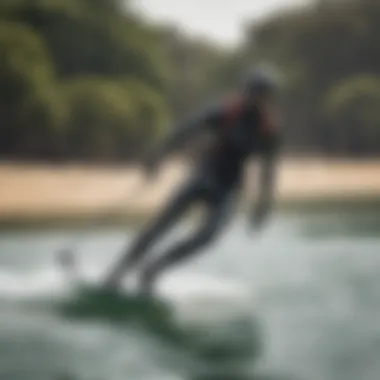The Essential Role of 5ml Wetsuits in Kiteboarding


Intro
For many kiteboarding enthusiasts, the right gear can be the difference between a thrilling experience and a chilly struggle. Among the essentials, a high-quality 5ml wetsuit often stands out, offering the warmth and flexibility vital for enjoying the sport in various conditions. But why focus specifically on 5ml wetsuits? The answer lies in their striking balance between insulation and maneuverability, making them ideal for both temperate climates and those brisk falls when the water cools.
5ml wetsuits are designed to keep kiteboarders comfortable as they navigate the swells and gusts of wind. With a suit hugging the body, riders can maintain mobility and safely push their limits. You may think that choosing any wetsuit would suffice, however, a suited fit tailored to the specific demands of kiteboarding is paramount. It enhances not just performance, but safety as well, allowing riders to focus on perfecting their craft.
In this piece, we will explore the intricate aspects of these wetsuits, delving into their construction, design choices, and upkeep—everything necessary for riders who wish to elevate their kiteboarding adventures. We'll also touch on how weather and water conditions affect your choice of wetsuit and highlight the importance of fit. Whether you are a seasoned pro or a budding kitebugger, this guide will help you make informed gear selections that suit your specific needs.
Foreword to Wetsuits in Kiteboarding
Wetsuits play a pivotal role in the kiteboarding community, acting not only as protective gear but also as a second skin that enhances the overall experience on the water. Understanding how these suits function and their evolution over time offers valuable insights into their significance. Kiteboarding is an aquatic sport where athletes propel themselves across the surface of the water, often in varying weather conditions. This means that the right wetsuit isn't merely a comfort choice, but a necessity for safety and performance.
A wetsuit essentially creates a thin layer of water between the suit and the skin, which gets warmed by body heat. This thermal layer will keep a rider warm in chilly waters, thus extending the season and improving performance during cooler months. Without such protection, kiteboarders are at risk of hypothermia, which can be pretty dangerous when you're out on the waves.
Moreover, environmental factors such as water temperature and wind can dramatically impact a kiteboarder's comfort and safety. Selecting the appropriate wetsuit ensures riders can enjoy their time on the water without the discomfort of cold or wet skin. With advancements in technology, the materials and designs of wetsuits have evolved radically, constructing them not only for warmth but also for optimal performance.
"Choosing the right wetsuit is akin to finding the right kite. It determines how well you can perform and how safe you feel while riding."
The significance of wetsuits in kiteboarding extends beyond thermal insulation—they offer buoyancy, ease of movement, and in some cases, impact protection from falls. In the following sections, we will explore the specifics of a 5ml wetsuit, touching on its design, function, and the features that make it a popular choice among avid kiteboarders.
Definition and Purpose of Wetsuits
Wetsuits are specialized garments designed for water sports. They may look somewhat simple at first glance, but their purpose is multi-faceted. A wetsuit serves mainly to provide thermal insulation, protecting the body from cold water temperatures. This insulation is achieved by trapping a thin layer of water between the suit and the skin, which, when warmed by the body, acts as an insulator.
Apart from thermal protection, wetsuits also cater to various performance needs. They are built to minimize drag, allowing for freer movement in the water. The materials used in wetsuits vary, but they generally consist of neoprene, which offers both flexibility and buoyancy, two critical elements in kiteboarding. Additionally, wetsuits can offer some UV protection, reducing the risk of sunburn during prolonged exposure to sunlight on the water.
Historical Evolution of Wetsuits
The journey of wetsuits began in the early 1950s with a phased approach to tackle various water-specific challenges. Initially, pioneers designed simple rubber suits primarily for surfing. These early models were bulky and less flexible, not ideal for the quick movements required in fast-paced sports like kiteboarding.
As surfing gained popularity, advancements in materials led to the development of neoprene, revolutionizing wetsuit design. This new material provided the necessary stretch and warmth without the bulk, making it more suitable for various water sports, including kiteboarding. Over the following decades, manufacturers began to focus on refining fit and reducing drag, ultimately resulting in the sleek, form-fitting wetsuits we see today.
Modern wetsuit technology includes features like thermal linings, sealed seams to prevent water entry, and variations in thickness for different water conditions—all rooted in the understanding of the needs presented by specific sports. Today’s wetsuits like the 5ml variation are considered essential equipment for kiteboarders, supporting safety and performance in unpredictable waters.
Understanding 5ml Wetsuits
Grasping the ins and outs of 5ml wetsuits is critical for anyone serious about kiteboarding. This thickness strikes a balance, making it suitable for varying water temperatures while providing the agility and comfort necessary for this dynamic sport. Kiteboarding isn't just about the thrill of flying across the water; it’s essential to have gear that enhances performance and keeps the body safe.
Key Features of 5ml Wetsuits
5ml wetsuits are specifically designed to provide insulation and protection without sacrificing movement. Here are some standout features that make them unique:
- Neoprene Thickness: At 5ml, the neoprene provides a warm barrier in cooler waters, often suited for transitional seasons.
- Flexibility: Compared to thicker wetsuits, 5ml models offer a good range of motion, essential for executing jumps and turns.
- Zipper Configurations: Many come with various styles of entry points. Back zippers provide convenience, while chest zippers can enhance flexibility.
- Glued and Blind-Stitched Seams: These seams are crucial in keeping water from flushin' in, thus aiding warmth retention.
These features combine to enhance the overall kiteboarding experience. They ensure performers stay comfortable and are able to maneuver their boards without any hindrance.
Material Composition and Benefits
The material used in 5ml wetsuits is predominantly a high-grade neoprene. This material is not just acclaimed for its insulating properties but also for other noteworthy benefits:
- Lightweight: Unlike older models made from heavier materials, modern neoprene is designed to feel light, allowing kiteboarders to execute high-energy moves with ease.
- Durability: A good 5ml wetsuit made from quality neoprene can withstand the rigors of water sports. After all, no one wants a suit that wears out after a few sessions.
- Thermal Insulation: This thickness is engineered to trap a layer of water between the suit and the skin, allowing the body’s heat to warm that layer, keeping kiteboarders snug in colder conditions.
"A suitable wetsuit can make the difference between an enjoyable ride and a chilly day spent shivering on the water."
To summarize, understanding the 5ml wetsuit landscape is essential for kiteboarders who are keen on optimizing their gear. A combination of flexible design, high-quality materials, and thoughtful construction leads to a successful and comfortable kiteboarding experience.
Selecting the Right 5ml Wetsuit
Choosing a 5ml wetsuit might seem straightforward, but a little thought can go a long way in enhancing your kiteboarding experience. This decision affects not just your comfort level, but also your overall performance on the water. A well-fitted wetsuit can make the difference between a thrilling ride and a frosty ordeal. So, let’s break down the essential elements to keep in mind when selecting a wetsuit that suits your unique needs and style.


Sizing and Fit Considerations
When it comes to wetsuits, size does matter—perhaps more than you might expect. A wetsuit that fits like a glove keeps the chill at bay while allowing for unrestricted movement. On the contrary, a suit that’s too loose can let water in, cooling you off quicker than a snowstorm in July.
Here are a few tips for nailing that perfect fit:
- Measurements Matter: Take accurate measurements of your chest, waist, hips, and inseam. Different brands may have slightly varying sizing charts, so it’s prudent to consult those before making your choice.
- Try Before You Buy: If you're able to, a test fitting is invaluable. When you try on the wetsuit, move around as if you were about to hit the waves. Bend and twist your torso to ensure freedom of movement. You want it to feel snug, but not like you're wearing a straightjacket.
- Don’t Skip on the Neck: A common pitfall when trying wetsuits is ignoring the neckline. A high neckline can help eliminate water gaps, while a neckline that's too loose may become a channel for chilly water.
- Consider the Layering: If you tend to layer under your wetsuit in cooler weather, make sure the fit accommodates that extra layer without feeling like you're encased in a sausage casing.
Assessing Personal Needs and Usage Scenarios
Your selection should also be guided by your personal needs and the type of kiteboarding you intend to do. Not every conditions calls for a 5ml wetsuit, but when it fits the bill, understanding the context can help narrow your options.
- Water Temperatures: The waters you kiteboard in play a pivotal role in your decision. Generally, 5ml wetsuits are recommended for waters ranging between 10 to 15 degrees Celsius. Below that, you might be better off with a thicker option.
- Duration of Sessions: If you plan on long sessions, consider how long you'll be exposed to colder water. Spending hours on the water can exhaust your body, even if that wetsuit fits well.
- Intensity of Activity: Kiteboarding can involve a fair amount of physical movement, from jumps to sudden changes in direction. If you’re a high-energy rider, ensure that your suit permits a full range of motion.
- Future Intentions: If you plan to venture into extreme conditions or harsher environments in the future, it could be worth investing in a durable 5ml option that can handle it all.
"Your wetsuit is not just gear; it's your second skin on the water. Choose wisely and enjoy the ride!"
To sum it up, selecting the right 5ml wetsuit goes beyond weighing the pros and cons of materials or styles. It's about finding that sweet spot where comfort and performance meet personal needs. A little time spent on this decision pays dividends once you hit the waves.
Performance Aspects of 5ml Wetsuits
In the ever-evolving world of kiteboarding, the performance of gear can be the difference between an exhilarating day on the water and a soggy frustration. Among the myriad choices available, the 5ml wetsuit stands out for its ability to offer a balanced approach to warmth and mobility. Performance is not merely about staying warm in chilly waters; it's also about the freedom to maneuver and enjoy the ride.
Thermal Regulation and Comfort
Thermal regulation is arguably the most critical factor when considering a 5ml wetsuit. This is particularly true for kiteboarders who often find themselves in variable weather conditions. Unlike the burn of summer sun, colder temperatures can sneak up unannounced. A well-constructed 5ml wetsuit sloughs off the chill while keeping you comfortable.
The suit's unique neoprene composition manages body heat effectively. Neoprene is made up of tiny bubbles of gas, providing insulation while allowing some flexibility. You can fly down the waves without feeling like a popsicle. The inner lining of the suit often features materials that wick moisture away from the skin, ensuring that you maintain not just warmth but also comfort during longer sessions on the water.
Consider this: a study from Britannica indicated that even slight dips in body temperature can impair performance. So, a wettie that keeps you warm while allowing sweat to escape is invaluable. Ultimately, thermal regulation isn’t just about staying cozy; it directly affects your ability to focus on the task at hand. You want to be thinking about navigation, wind direction, and not whether you're losing feeling in your limbs.
Mobility and Design Innovations
Mobility in a wetsuit is a function of design and material choice. Gone are the days when wearing a thick rubber suit meant you’d feel like a tin can on the water. Modern 5ml wetsuits often come with articulations and flexible panels that allow for a natural range of motion. Kiteboarders need to twist and turn, jump and dive, and their wetsuits must work with them, not against them.
Many manufacturers are now incorporating innovative features that enhance mobility without sacrificing warmth. For example, Glued and blind stitched seams can minimize water entry while maintaining flexibility. This means less cold water seepage slows you down, allowing a more fluid experience. High-stretch neoprene panels are another common feature that aids mobility, providing elasticity where it counts.
It's not just about what the wetsuit is made of, but how it's structured. The latest designs often include segmented patterns that allow the fabric to stretch and move as you do. For instance, when you reach for the kite, the suit bends comfortably with you, keeping you agile.
Additionally, open-cell versus closed-cell neoprene also plays a role in mobility. Open-cell suits provide more stretch and comfort but are less water-resistant than closed-cell types. Understanding the balance between insulation and flexibility is pivotal.
"In kiteboarding, the right wetsuit feels like a second skin, letting you dance on the waves without thinking about it."
This harmony between thermal comfort and mobility reflects the evolution of wetsuit technology, tailored to enhance performance in the diverse conditions faced by kiteboarders.
In summary, when discussing the performance aspects of 5ml wetsuits, we see that thermal regulation goes hand-in-hand with mobility. Each feature is meticulously crafted not just for the sake of technology but to empower the rider on the water. As technology advances, we can expect even greater innovations that deepen this connection between the rider and their suit. This crucial interplay significantly enhances the kiteboarding experience.
Environmental Considerations for Wetsuits
When discussing 5ml wetsuits in the context of kiteboarding, it’s crucial to look beyond the surface of performance and comfort. The choices we make about our gear can significantly impact the environment, especially the marine ecosystems we love to engage with. Understanding the environmental considerations related to wetsuits encourages kiteboarders to make more informed decisions that not only enhance their experience on the water but also contribute positively to the planet.
Impact on Marine Life
The production, use, and disposal of wetsuits can have a profound effect on marine wildlife. Most wetsuits are made from neoprene, a material derived from petrochemicals. This not only requires significant energy to produce but also involves a pollutants that can seep into the ocean during manufacturing processes.
Furthermore, when we wear wetsuits while engaging in kiteboarding, small particles can shed off the suit. This litter isn’t just an eyesore; it can disrupt underwater habitats and be harmful to creatures like fish and crustaceans. Reports have indicated the presence of microplastics in marine environments, which are ingested by marine organisms, causing detrimental effects up the food chain.
- Sustainability matters: As watermen, being respectful of marine life should be paramount. Choosing wetsuits that utilize safer alternatives to neoprene can help mitigate harm to our oceans.
- Awareness is key: By being aware of our impact on marine ecosystems, we empower ourselves to make choices that align with preserving the environment.
Sustainable Materials and Practices


In the face of environmental challenges, many brands have begun to create wetsuits using sustainable materials. For instance, companies like Patagonia and O’Neill have pioneered products made from limestone-based neoprene or natural rubber, which offers a far lesser carbon footprint compared to traditional neoprene. These innovations signify the industry's shift towards being more eco-conscious.
Here are several notable approaches that support environmental sustainability in wetsuit design:
- Recycled materials: Some manufacturers are producing wetsuits from recycled plastics or ocean waste, demonstrating a commitment to reducing environmental impact.
- Durable construction: Investing in high-quality wetsuits that last may reduce the frequency of replacement, leading to less waste.
- Biodegradable options: Emerging biodegradable wetsuits represent a potential game-changer for end-of-life concerns, allowing for a more responsible disposal option.
Utilizing sustainable materials not only helps in reducing the carbon footprint but also addresses the growing demand for eco-responsibility in the watersport industry. As kiteboarders, we can support brands with ethical practices and lean towards purchases that reflect our commitment towards marine conservation.
"By aligning our passions with eco-conscious choices, we can enjoy our water sports while also respecting the beauty of our oceans."
Caring for Your 5ml Wetsuit
Taking care of your 5ml wetsuit is not just a matter of routine; it’s vital for the longevity and performance of the gear that accompanies you on those exhilarating kiteboarding adventures. Proper care ensures that your wetsuit maintains its thermal properties, flexibility, and can withstand the rigors of the surf, enhancing both your comfort and safety. Here, we’ll break down essential aspects of wetsuit care to furnish you with the insight required to protect your investment.
Proper Washing Techniques
To keep your 5ml wetsuit fresh and functional, proper washing is key. After each session, it's all about rinsing the saltwater or chlorine out if you've been at a pool. Consider this step akin to giving your wetsuit its own little spa treatment. Here’s how to go about it:
- Rinse Thoroughly: As soon as you're back on dry land, rinse your wetsuit inside and out with cool, clean water to eliminate any residual salt, sand, or debris that can wear down the material over time.
- Use Gentle Soap: Every now and then, a gentle wetsuit-specific soap can be employed. Avoid fabric softeners and bleach, as they can wreak havoc on the neoprene, compromising insulation and elasticity.
- Lay Flat to Dry: After washing, lay your wetsuit flat in a shaded area. Hanging it by the shoulders can stretch the fabric, leading to an ill fit later on. Keep it out of direct sunlight, which can degrade the material.
Taking these steps can not only keep the wetsuit smelling less like a fish market but also extend its usable life considerably.
Storage and Maintenance Tips
When the boards are put away for the season, there’s a right way to store your wetsuit. The ultimate goal is to find a sweet spot where it avoids damage yet stays ready for action when needed again. Consider the following tips:
- Avoid Folds and Creases: When stashing away the wetsuit, roll it loosely instead of folding it to prevent undesired creases which may weaken the seams.
- Use Suits Hanger: If you need to hang it, employ a specialized wetsuit hanger to distribute the weight evenly.
- Store in a Cool, Dry Place: A dark cupboard or closet is ideal; warmth can cause the neoprene to deteriorate.
- Occasional Check-Up: Regularly inspect for any signs of wear, tears, or mildew, especially if it's been stored for a spell. Address repairs swiftly to keep the suit in top condition.
It's not just about keeping it clean—it's about treating your wetsuit like the specialized piece of equipment it is. Ultimately, proper washing and storage can make a world of difference, ensuring your 5ml wetsuit performs effectively every time you hit the waves.
Comparing 5ml Wetsuits with Other Thicknesses
When it comes to kiteboarding, understanding how 5ml wetsuits stack up against their thinner and thicker counterparts is crucial. Different thicknesses serve distinct purposes, providing varying levels of insulation, flexibility, and protection. This comparison not only highlights the advantages of 5ml wetsuits but also helps enthusiasts make informed choices based on their unique riding conditions.
Advantages of 5ml over Thinner or Thicker Options
Choosing a 5ml wetsuit can often be seen as a sweet spot within the spectrum of thickness. Here are some benefits that make 5ml a compelling choice for many kiteboarders:
- Optimal Insulation: 5ml wetsuits provide sufficient warmth without being overly bulky. This is particularly important during cooler months where kiteboarders need to fend off cold water while still enjoying sufficient mobility.
- Enhanced Flexibility: Many riders may find thinner wetsuits too limiting in terms of warmth, whereas thicker options can feel cumbersome. A 5ml wetsuit strikes that balance, allowing for fluid movements crucial in the dynamic nature of kiteboarding.
- Durability: Often, thicker suits can be less durable due to the heavier material. In contrast, 5ml wetsuits still offer robust construction while allowing for a degree of flexibility that prevents wear and tear.
- Versatility: The 5ml option can accommodate various water temperatures. It's a versatile choice for riders who may venture into both chilly and slightly warmer waters, saving them from investing in multiple suits.
"Finding a good wetsuit is about more than just thickness; it’s about comfort, flexibility, and staying warm!"
Situations Favoring Thinner or Thicker Wetsuits
The choice of wetsuit thickness often hinges on specific water conditions, air temperatures, and personal preference. Here are key instances when opting for thinner or thicker suits is more advantageous:
- Thinner Wetsuits (3mm or less)
- Thicker Wetsuits (6mm and above)
- Ideal for warmer waters where insulation is less critical.
- Great for summer months when kiteboarding is popular, enabling maximum range of motion.
- Recommended for riders who prioritize stretch and comfort over thermal protection.
- Essential during winter months in colder climates to prevent hypothermia.
- Provide substantial protection against stabbing pains from cold water shock.
- Suitable for those who stay in the water for extended periods in frigid temperatures, ensuring safety and comfort.
By understanding the nuances of each thickness, kiteboarders can better gauge their gear needs based on the given environmental conditions. This type of critical thinking can make the difference between a successful session on the water and a regrettable experience caught out in unexpected temperatures.
The Role of Wetsuits in Safety
Wetsuits are not just about comfort or style; they play a crucial role in safety for kiteboarders. The unpredictable nature of wind and water conditions makes it imperative for riders to take every precaution to ensure their well-being while enjoying their sport. A good wetsuit not only helps maintain body temperature but also provides protection against physical hazards in the water.
Protection Against Cold Water Shock


Cold water shock is a serious concern for those navigating the icy depths of lakes or oceans. When entering cold water—even for a brief moment—your body's initial response can be one of panic. The sudden drop in temperature can cause involuntary gasping and hyperventilation, which can be dangerous while riding. A 5ml wetsuit is designed to insulate your body and greatly limit exposure to the cold. This insulating layer keeps your core warm, allowing you to maintain control of your breathing and reactions should an accident occur.
- Enhanced Insulation: A 5ml wetsuit provides a considerable thickness to keep the cold at bay.
- Regulation of Body Temperature: Unlike thinner suits, a 5ml wetsuit helps regulate your body temperature more effectively, allowing longer rides in cooler conditions.
"A wetsuit's effectiveness in protecting against cold water shock can mean the difference between a thrilling session and a life-threatening scare."
Additionally, the snug fit of a wetsuit reduces the risk of water pooling inside, which can lead to a loss of body heat. It seals off your body's warmth while providing a comfortable layer that allows for better movement and reduced risk of hypothermia.
Navigating Potential Hazards While Kiteboarding
Kiteboarding is an exhilarating sport, but it comes with its own set of risks. Aside from cold water, there are physical dangers present, such as sharp rocks, jellyfish, or sudden changes in water conditions. A well-fitting wetsuit acts as a protective barrier, minimizing injuries from any unexpected encounters. The thick neoprene material helps shield the skin from abrasions, cuts, and stings, making it essential for a safe kiteboarding experience.
- Barrier Against Chafing and Cuts: The thick layer helps prevent friction between the skin and the harness, which is crucial during high-speed maneuvers.
- Reduced Risk of Injury: The extra padding provided by a wetsuit can offer protection against impacts from equipment or natural obstacles present in the waters.
Moreover, many modern wetsuits come equipped with features like reinforced seams and added buoyancy, which enhance overall safety. An awareness of these protective attributes can guide novices in making tailored choices for their equipment, reflecting on how crucial a wetsuit can be to their kiteboarding adventures.
Technological Innovations in Wetsuit Design
Wetsuit technology has come a long way, and the advancements in recent years have significantly enhanced the experience of kiteboarders. The innovations cover a broad spectrum, from materials to assembly techniques, and they've fundamentally changed how enthusiasts enjoy their time on the water. Understanding these technological advances is crucial for anyone serious about kiteboarding, as they directly influence performance, comfort, and safety.
Advancements in Material Science
Material science has become a pivotal part of wetsuit development. Modern wetsuits are now crafted using advanced synthetic materials that are not only lightweight but also provide superior thermal insulation. For instance, neoprene has evolved, introducing variations like limestone-based neoprene, which is more environmentally friendly and offers better stretchability. This can make a huge difference during those chilly kiteboarding sessions when staying warm is a priority.
- Benefits of New Materials:
- Flexibility: Better materials allow for increased range of motion, essential for performing tricks and maintaining control on the board.
- Durability: Advanced substances resist abrasions and tears, meaning your wetsuit will last longer, even if you find yourself frequently crashing into waves.
- Water Resistance: Improved water-repellent features prevent that cold water from seeping in, keeping you warm and comfortable throughout your ride.
These materials also consider ecological impacts, as sustainable manufacturing practices are becoming more common. Firms are looking for ways to reduce their carbon footprint and promote a greener approach to gear production, which benefits not just kitesurfers but the oceans they cherish.
Enhanced Sealing and Construction Methods
Another area of innovation lies in the sealing and construction methods used in wetsuits. The traditional flatlock seams, although robust, do not keep water entirely out. Recent techniques such as liquid seal or welded seams have changed the game by creating a waterproof barrier that minimizes leaks and thus maximizes warmth.
- Key Construction Techniques:
- Glued and Blind-Stitched Seams: This process involves gluing the seams before stitching, making them much less permeable to water.
- Taped Seams: Adding an internal tape to the seams prevents water from entering and adds durability by reinforcing vulnerable areas.
- Zipper Innovations: Efforts have been made to develop watertight zippers, which completely shut off any paths for water entry, a fundamental aspect when considering frigid conditions of the ocean.
With these improvements, kiteboarders can confidently face chilly waters, knowing that their gear will perform under the most demanding conditions.
The emergence of advanced sealing methods means kiteboarders can stay focused on their performance rather than battling the cold.
All said and done, these technological innovations ensure that there is not just simple evolution but a revolution in how wetsuits are perceived and experienced by users. Keeping abreast of such advancements will help kiteboarding enthusiasts make well-informed choices, ensuring safety and optimum performance on their adventures.
Finale: The Importance of Choosing the Right Wetsuit
Selecting the appropriate wetsuit is critical, especially for kiteboarders who spend considerable time in unpredictable and often cold water. A well-fitted wetsuit can make the difference between an enjoyable day on the water and an uncomfortable, even dangerous, experience. Choosing the right wetsuit directly impacts comfort, thermal insulation, and mobility, all essential elements for both novice and seasoned riders.
Key Considerations to Keep in Mind:
- Fit and Comfort: A wetsuit should fit snugly without restricting movement. A poorly fitting suit can lead to chafing, water entry, and a less enjoyable experience overall.
- Material Thickness: 5ml wetsuits provide a great balance, suitable for moderate temperature ranges. Understanding when to opt for a 5ml suit over thinner or thicker alternatives is crucial to maximize performance and safety.
- Usage Context: The environment plays a huge role. Knowing if you're heading into colder waters or dealing with strong winds aids in making an informed choice.
Summation of Key Points
In retrospect, several pivotal aspects emerged throughout our exploration:
- 5ml wetsuits stand out for their versatility, bridging the gap between mobility and thermal protection.
- The material components offer a spectrum of benefits, including durability, stretchability, and warmth retention.
- Proper care and maintenance extend the lifespan of these suits significantly, ensuring maximum performance.
- Awareness of personal comfort and environmental conditions helps in making an optimal selection of a wetsuit.
To Summarize: An informed choice leads to enhanced performance, safety, and enjoyment.
Final Thoughts on Kiteboarding Gear Considerations
In the realm of kiteboarding, gear choices are not mere accessories but vital components that impact overall experience. 5ml wetsuits epitomize this sentiment, as they balance warmth and flexibility. The world of kiteboarding is unpredictable, and a well-chosen wetsuit serves as a reliable ally against those chill-inducing waters.
Furthermore, as technology advances, innovations in materials and design enhance what's available to riders today. Staying abreast of these developments can not only improve comfort and safety but also contribute positively to one’s performance on the water.
As you ponder your next adventure, reflect on your gear. After all, the right wetsuit does not merely protect but amplifies the joy of riding, making every session a thrilling encounter with the elements.















